N Cadherin Recombinant Rabbit Monoclonal Antibody [SY02-46]

cat.: ET1607-37
| Product Type: | Recombinant Rabbit monoclonal IgG, primary antibodies |
|---|---|
| Species reactivity: | Human, Mouse, Rat, Cynomolgus monkey, Pig |
| Applications: | WB, IHC-P, IHC-Fr, IF-Tissue |
| Clonality: | Monoclonal |
| Clone number: | SY02-46 |
| Form: | Liquid |
| Storage condition: | Shipped at 4℃. Store at +4℃ short term (1-2 weeks). It is recommended to aliquot into single-use upon delivery. Store at -20℃ long term. |
| Storage buffer: | 1*TBS (pH7.4), 0.05% BSA, 40% Glycerol. Preservative: 0.05% Sodium Azide. |
| Concentration: | 1ug/ul |
| Purification: | Protein A affinity purified. |
| Molecular weight: | Predicted band size: 100 kDa |
| Isotype: | IgG |
| Immunogen: | Synthetic peptide within Human N Cadherin aa 161-210 / 906. |
| Positive control: | 293T cell lysate, A549 cell lysate, HeLa cell lysate, A-172 cell lysate, MCF7 cell lysate, C2C12 cell lysate, C6 cell lysate, mouse liver tissue, rat liver tissue, human liver carcinoma tissue, human liver tissue, mouse heart tissue, Hela. |
| Subcellular location: | Cell membrane. |
| Recommended Dilutions:
WB IHC-P IHC-Fr IF-Tissue |
1:5,000-1:20,000 1:10,000-1:40,000 1:500-1:1,000 1:2,000 |
| Uniprot #: | SwissProt: P19022 Human | P15116 Mouse | Q9Z1Y3 Rat |
| Alternative names: | CADH2_HUMAN Cadherin 2 Cadherin 2 N cadherin neuronal Cadherin 2 type 1 Cadherin 2 type 1 N cadherin neuronal Cadherin 2, type 1, N-cadherin (neuronal) Cadherin-2 Cadherin2 Calcium dependent adhesion protein neuronal CD325 CD325 antigen CDH2 CDHN CDw325 CDw325 antigen N cadherin 1 N-cadherin NCAD Neural cadherin OTTHUMP00000066304 OTTHUMP00000067378 |
Images
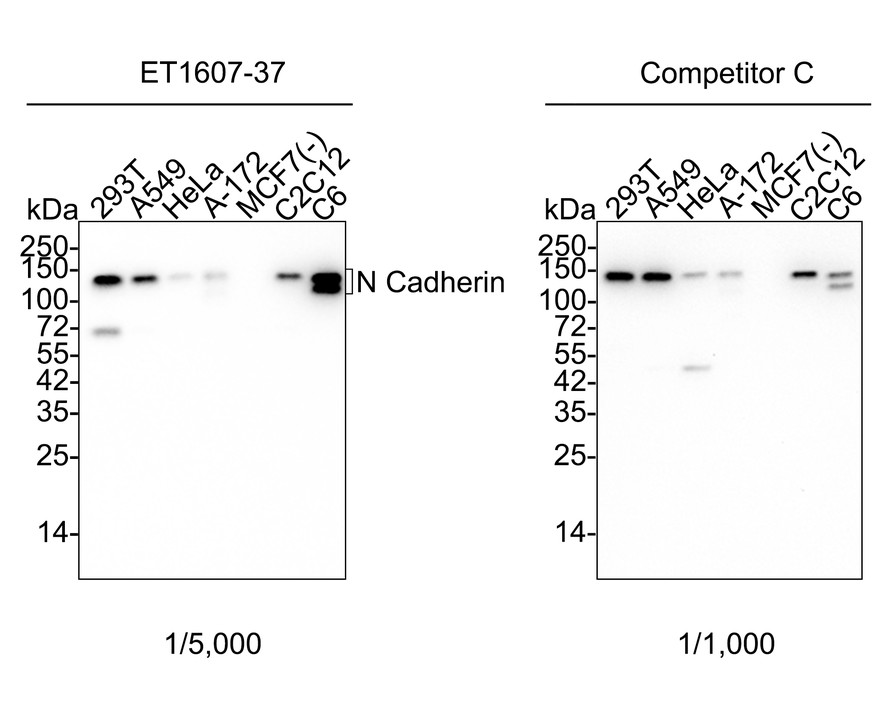
|
Fig1:
Western blot analysis of N Cadherin on different lysates with Rabbit anti-N Cadherin antibody (ET1607-37) at 1/5,000 dilution and competitor's antibody at 1/1,000 dilution. Lane 1: 293T cell lysate Lane 2: A549 cell lysate Lane 3: HeLa cell lysate Lane 4: A-172 cell lysate Lane 5: MCF7 cell lysate (negative) Lane 6: C2C12 cell lysate Lane 7: C6 cell lysate Lysates/proteins at 15 µg/Lane. Predicted band size: 100 kDa Observed band size: 140-150 kDa Exposure time: 2 minutes 6 seconds; ECL: K1801; 4-20% SDS-PAGE gel. Proteins were transferred to a PVDF membrane and blocked with 5% NFDM/TBST for 1 hour at room temperature. The primary antibody (ET1607-37) at 1/5,000 dilution and competitor's antibody at 1/1,000 dilution were used in 5% NFDM/TBST at 4℃ overnight. Goat Anti-Rabbit IgG - HRP Secondary Antibody (HA1001) at 1/50,000 dilution was used for 1 hour at room temperature. |
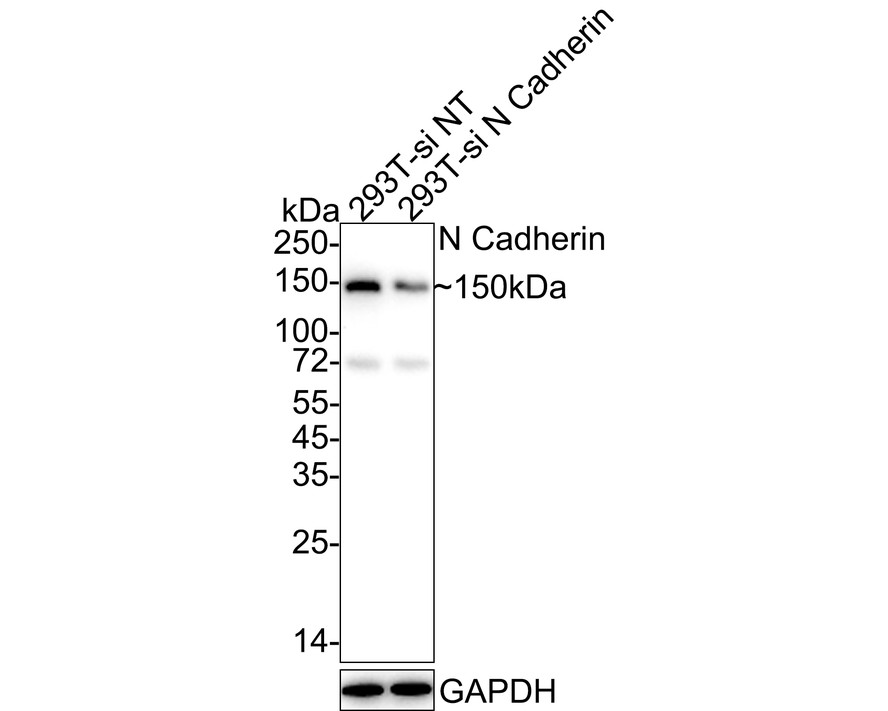
|
Fig2:
Western blot analysis of N Cadherin on different lysates with Rabbit anti-N Cadherin antibody (ET1607-37) at 1/5,000 dilution. Lane 1: 293T-si NT cell lysate (10 µg/Lane) Lane 2: 293T-si N Cadherin cell lysate (10 µg/Lane) Predicted band size: 100 kDa Observed band size: 150 kDa Exposure time: 1 minute 46 seconds; ECL: K1801; 4-20% SDS-PAGE gel. Proteins were transferred to a PVDF membrane and blocked with 5% NFDM/TBST for 1 hour at room temperature. The primary antibody (ET1607-37) at 1/5,000 dilution was used in 5% NFDM/TBST at 4℃ overnight. Goat Anti-Rabbit IgG - HRP Secondary Antibody (HA1001) at 1/50,000 dilution was used for 1 hour at room temperature. |
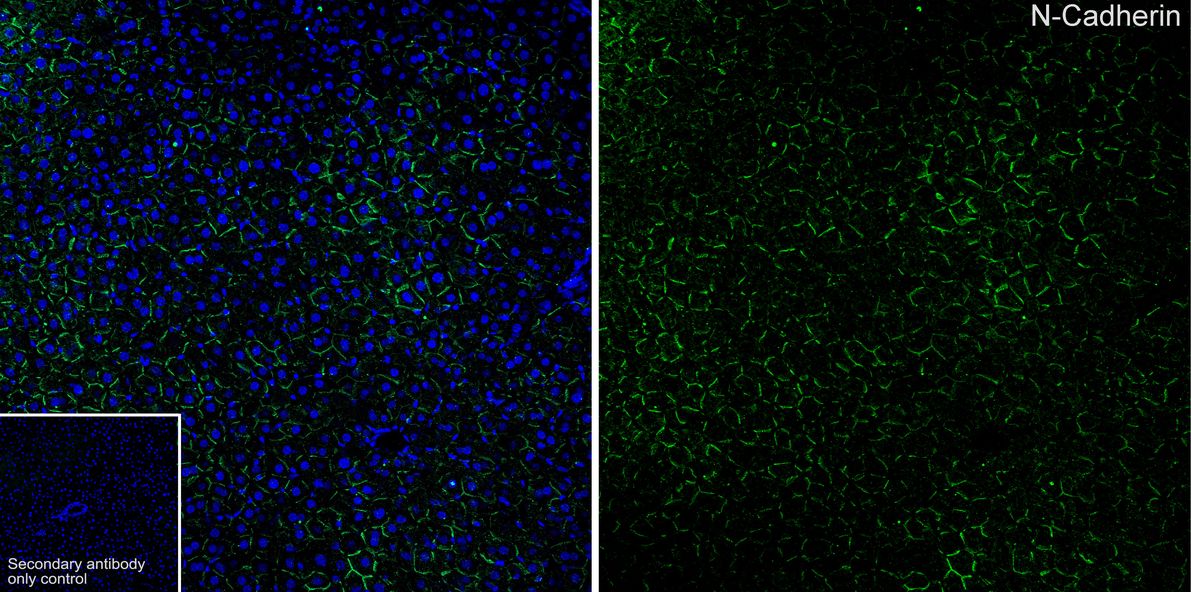
|
Fig3:
Application: IHC-Fr Species: Mouse Site: Liver Sample: Frozen section Antibody concentration: 1:500 Antigen retrieval: Recommend. The section was pre-treated using heat mediated antigen retrieval with sodium citrate buffer (pH 6.0) for about 2 minutes in microwave oven. |
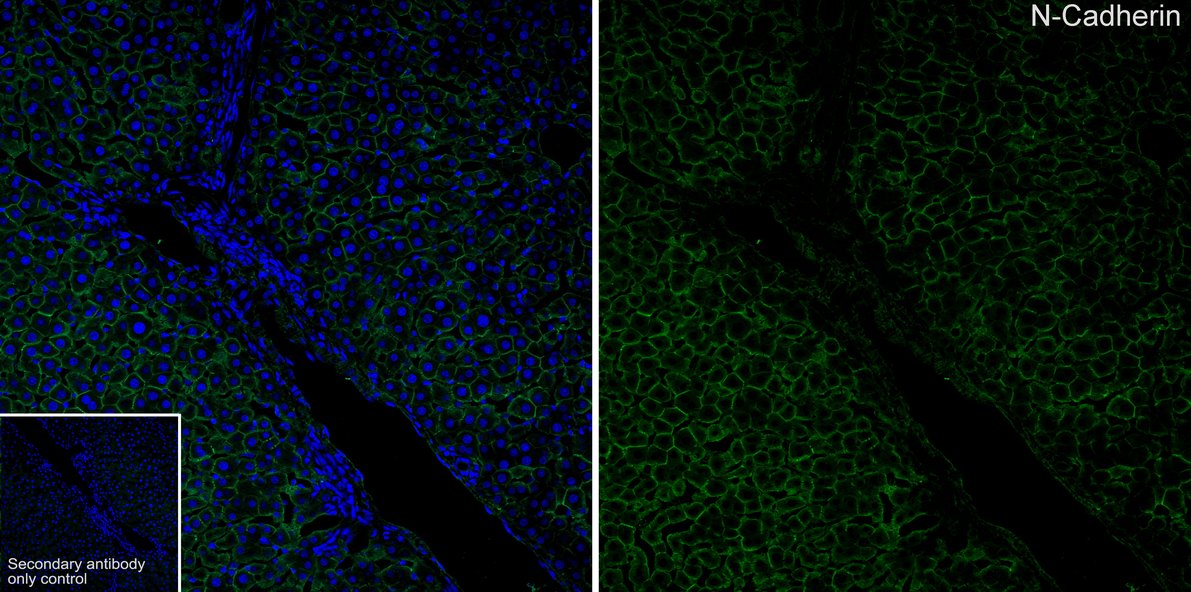
|
Fig4:
Application: IHC-Fr Species: Mouse Site: Liver Sample: Frozen section Antibody concentration: 1:500 Antigen retrieval: Recommend. The section was pre-treated using heat mediated antigen retrieval with sodium citrate buffer (pH 6.0) for about 2 minutes in microwave oven. |
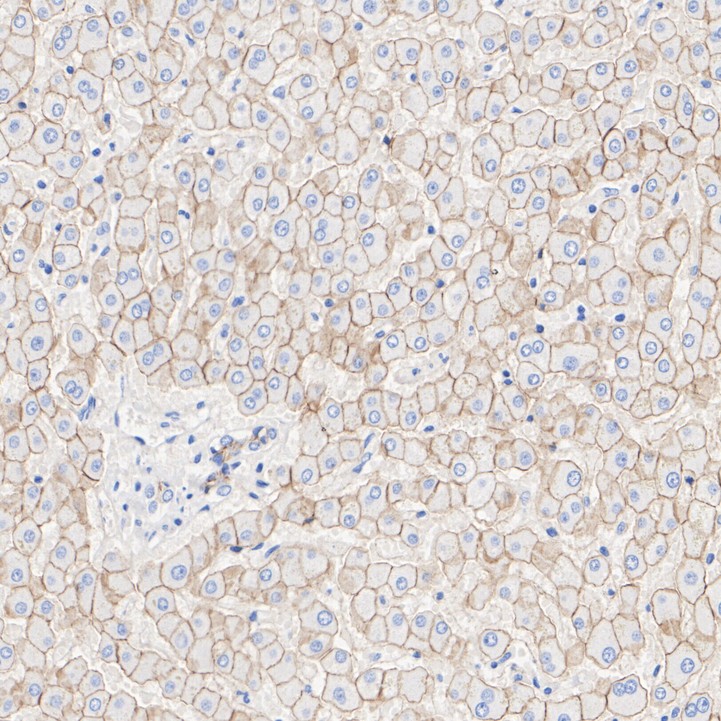
|
Fig5:
Immunohistochemical analysis of paraffin-embedded human liver tissue with Rabbit anti-N Cadherin antibody (ET1607-37) at 1/40,000 dilution. The section was pre-treated using heat mediated antigen retrieval with Tris-EDTA buffer (pH 9.0) for 20 minutes. The tissues were blocked in 1% BSA for 20 minutes at room temperature, washed with ddH2O and PBS, and then probed with the primary antibody (ET1607-37) at 1/40,000 dilution for 1 hour at room temperature. The detection was performed using an HRP conjugated compact polymer system. DAB was used as the chromogen. Tissues were counterstained with hematoxylin and mounted with DPX. |
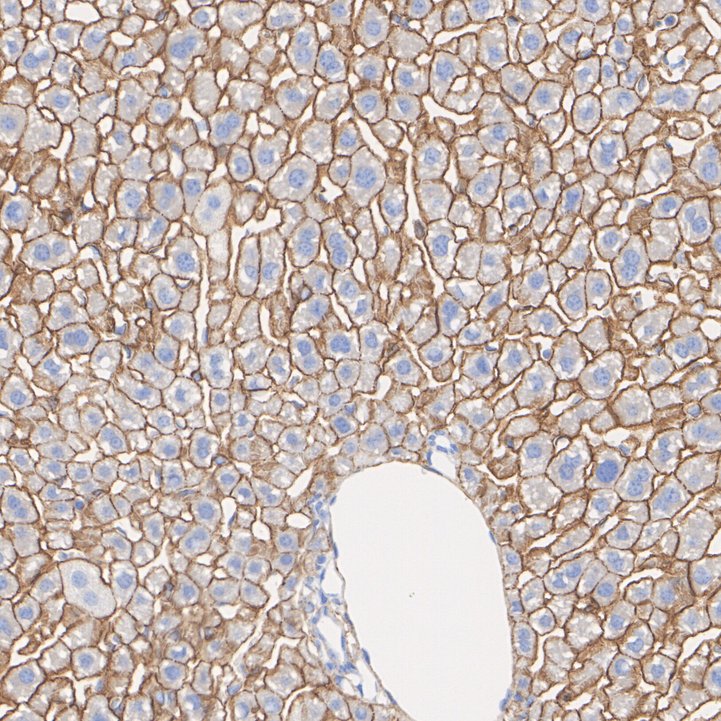
|
Fig6:
Immunohistochemical analysis of paraffin-embedded mouse liver tissue with Rabbit anti-N Cadherin antibody (ET1607-37) at 1/40,000 dilution. The section was pre-treated using heat mediated antigen retrieval with Tris-EDTA buffer (pH 9.0) for 20 minutes. The tissues were blocked in 1% BSA for 20 minutes at room temperature, washed with ddH2O and PBS, and then probed with the primary antibody (ET1607-37) at 1/40,000 dilution for 1 hour at room temperature. The detection was performed using an HRP conjugated compact polymer system. DAB was used as the chromogen. Tissues were counterstained with hematoxylin and mounted with DPX. |

|
Fig7:
Immunohistochemical analysis of paraffin-embedded rat liver tissue with Rabbit anti-N Cadherin antibody (ET1607-37) at 1/40,000 dilution. The section was pre-treated using heat mediated antigen retrieval with Tris-EDTA buffer (pH 9.0) for 20 minutes. The tissues were blocked in 1% BSA for 20 minutes at room temperature, washed with ddH2O and PBS, and then probed with the primary antibody (ET1607-37) at 1/40,000 dilution for 1 hour at room temperature. The detection was performed using an HRP conjugated compact polymer system. DAB was used as the chromogen. Tissues were counterstained with hematoxylin and mounted with DPX. |
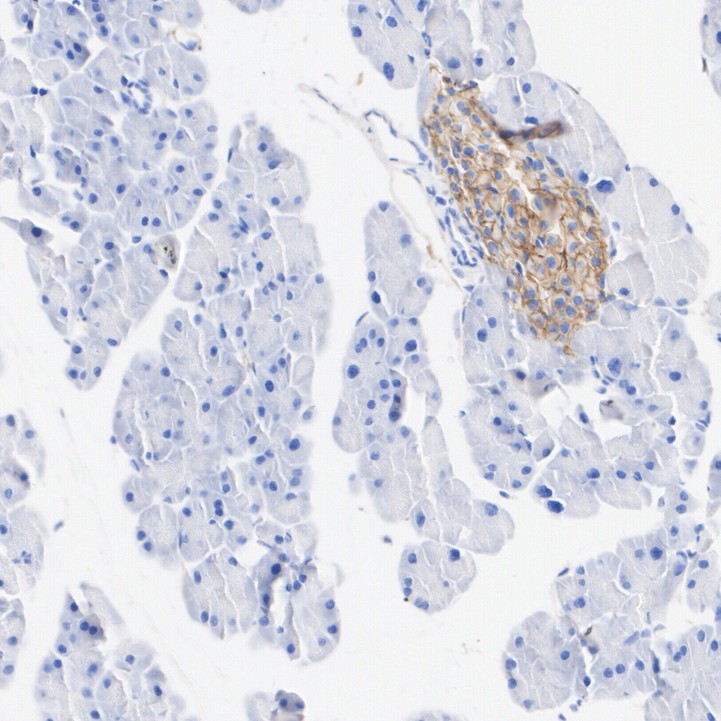
|
Fig8:
Immunohistochemical analysis of paraffin-embedded mouse pancreas tissue with Rabbit anti-N Cadherin antibody (ET1607-37) at 1/40,000 dilution. The section was pre-treated using heat mediated antigen retrieval with Tris-EDTA buffer (pH 9.0) for 20 minutes. The tissues were blocked in 1% BSA for 20 minutes at room temperature, washed with ddH2O and PBS, and then probed with the primary antibody (ET1607-37) at 1/40,000 dilution for 1 hour at room temperature. The detection was performed using an HRP conjugated compact polymer system. DAB was used as the chromogen. Tissues were counterstained with hematoxylin and mounted with DPX. |

|
Fig9:
Immunohistochemical analysis of paraffin-embedded rat pancreas tissue with Rabbit anti-N Cadherin antibody (ET1607-37) at 1/40,000 dilution. The section was pre-treated using heat mediated antigen retrieval with Tris-EDTA buffer (pH 9.0) for 20 minutes. The tissues were blocked in 1% BSA for 20 minutes at room temperature, washed with ddH2O and PBS, and then probed with the primary antibody (ET1607-37) at 1/40,000 dilution for 1 hour at room temperature. The detection was performed using an HRP conjugated compact polymer system. DAB was used as the chromogen. Tissues were counterstained with hematoxylin and mounted with DPX. |
Note: All products are “FOR RESEARCH USE ONLY AND ARE NOT INTENDED FOR DIAGNOSTIC OR THERAPEUTIC USE”.